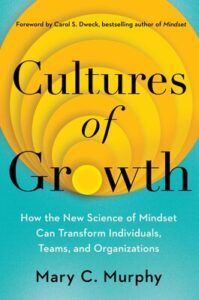Mindsets Are Not Just Found in Our Heads
Cultures of Growth: How the New Science of Mindset Can Transform Individuals, Teams and Organizations
By Mary C. Murphy
(Simon & Schuster, 2024 – Learn more)
Reviewed by Brad Waguespack


The instructor never said so, but each lesson and activity was framed as a learning experience, not as a test for the students. Now keep in mind this training was a certification in backcountry medicine, so it was vital that participants learn the essential content for their upcoming jobs.
Today I have been working for HIOBS for decades in various capacities and have piles of evidence that the school’s mindset is not ephemeral. Plus, as a classroom science teacher of 17 years, I have rarely experienced this type of culture outside of HIOBS. Then this summer Mary C. Murphy’s book Cultures of Growth fell into my lap, and reading it helped me understand what I had experienced.
As a teacher, each summer I try to read a book that will stretch and inspire my thinking for the upcoming school year. I think it was on a podcast where I heard Murphy’s book referenced, and I took a leap of faith and purchased it. If I am being honest, the book traveled to Europe with me where I hardly cracked its spine. Yet, upon my return and diving into my summer schedule, I read a chapter a day, loving and learning about each new dimension Murphy expands upon as she describes cultures of growth and cultures of genius.
Building on Carol Dweck’s research
Cultures of Growth: How the New Science of Mindset Can Transform Individuals, Teams and Organizations is in my opinion a logical next step to Carol Dweck’s foundational work in her best-selling book, Mindset.
Dweck’s text is not a prerequisite, but it helps if you are familiar with her argument that people approach learning with one of two mindsets: fixed or growth. A growth mindset is the belief that one’s characteristics, such as intelligence or abilities, can change over time, and a fixed mindset is when one believes that their traits are set in stone and change little from birth. These mindsets matter because they determine important factors (persistence, resiliency, etc.) that often inhibit or enrich the overall learning process.
Cultures of Growth builds upon Dweck’s research on individuals’ mindsets and applies her findings to the organizations and groups (businesses, churches, schools, etc.) where we work and spend our time. Murphy’s thesis is that “Mindset exists on a continuum. And where we fall on that continuum at any given moment often has to do with the situation we’re in and the people around us” (p.3).
Murphy dubs organizations that lean towards a growth mindset as cultures of growth or learning organizations while organizations that lean toward a fixed mindset are labeled as cultures of genius or leaning organizations since they lean on the status quo or how things were done in the past (p.55).
Understanding and realizing growth mindset’s potential
Cultures of Growth is broken into three parts with the first section building the reader’s understanding of the mindset continuum as a characteristic of both individuals and organizations. The second portion of the book addresses how cultures of growth and cultures of genius impact collaboration, innovation and creativity, risk-taking and resilience, integrity and ethical behavior and finally diversity, equity and inclusion within an organization.
The individual chapters start with a real-world example, usually from the business and technology world, where the organization’s mindset has influenced its current situation.
As a high school science teacher, I found it easy to draw parallels of these ideas in my classroom and school. When I was reading about how a culture of growth impacts collaboration and innovation, my mind went directly to my school’s Professional Learning Communities (PLC’s). For example, each week the teachers in my science PLC have the collective responsibility of planning and framing the upcoming classroom activities as opportunities to learn and grow or as occasions when the students need to prove themselves.
Murphy is clear that becoming aware of the collective mindset of the groups we work within (PLCs, departments or the whole school) is an important first step in leaning towards a growth mindset. She provides many examples of how organizations with cultures of growth are more resilient, dynamic and subsequently sustainable since they are risking, trying new things, and collaborating, allowing them to meet the ever-changing world.
She draws sharp contrasts with a culture of genius, where leadership often hires the best (geniuses) and facilitates internal competition to stay at the top which often leaves these organizations plateaued and stalled out in our evolving world.
The third section of the book really helps put these big ideas of mindsets as organizational cultures into practice because it focuses on four key situations that trigger our mindset. The triggers are evaluative situations, high-effort situations, critical feedback and the success of others. Each of these triggers happen weekly in my classroom and reading this section gave me practical ways of framing these common triggers so that my students (and myself) will lean into their growth mindset instead of a fixed one.
A culture of growth for our schools
Looking back over 20 years to that initial week at HIOBS, what was so attractive and contagious for me was that I was, for the first time, experiencing a culture of growth. A place of learning where we risked, collaborated with different people, and saw high stakes evaluation as an opportunity to grow.
We all deserve to work towards creating a culture of growth in our schools, and reading Murphy’s book is a wonderful place to start. This year, I am stepping away from the classroom to work with my fellow teachers as an Instructional Partner. It is my utmost goal to help cultivate, in myself and in the educators I work alongside, a culture of growth so that it is modeled successfully by our students, and they grow, too.
Brad Waguespack has been teaching science for 17 years. He loves sharing learning opportunities with his students that highlight the complexity and beauty in the natural world. This fall he has begun a new position as an Instructional Coach at Vestavia Hills (AL) High School.





























